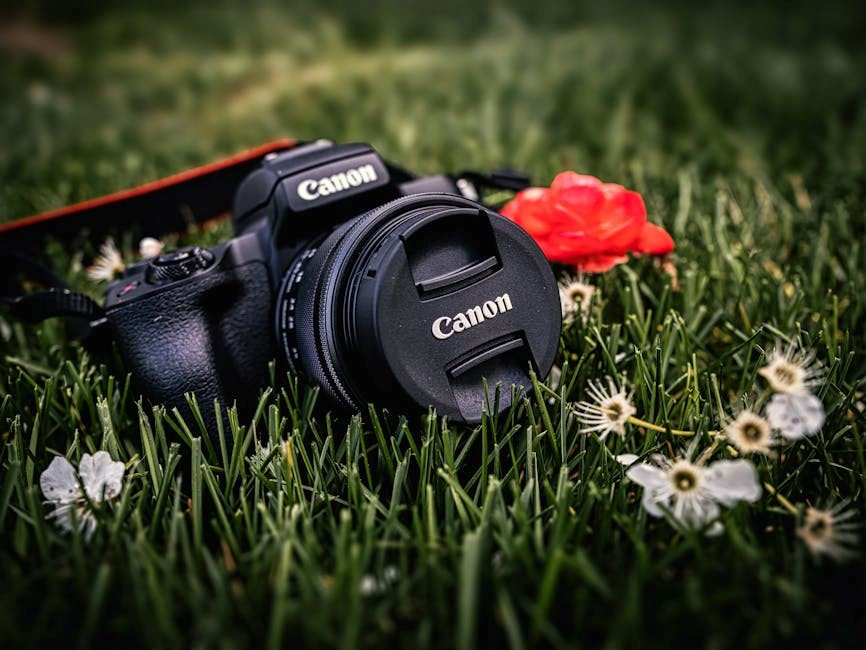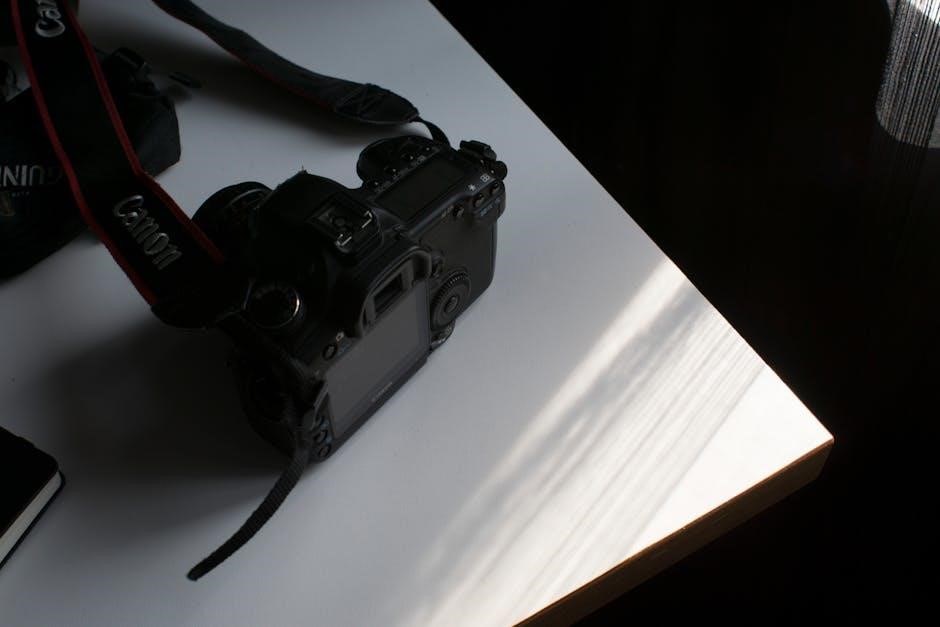
The Canon SX50 HS is a versatile and powerful camera designed for capturing stunning images with exceptional detail and clarity. It offers advanced features, making it ideal for both enthusiasts and professionals seeking high-quality photography.
1.1 Overview of the Camera
The Canon SX50 HS is a high-performance digital camera designed for versatile photography. It combines a powerful 50x optical zoom lens with a 12.1-megapixel CMOS sensor, delivering sharp images even at long distances. The camera features a DIGIC 5 image processor, ensuring fast operation and excellent image quality. With built-in image stabilization, it reduces blur caused by hand movement or low light. Its ergonomic design and intuitive controls make it easy to handle, while its advanced features cater to both casual users and photography enthusiasts, offering a balance of simplicity and creativity.
1.2 Key Features of the Canon SX50 HS
The Canon SX50 HS boasts a 50x optical zoom and 100x digital zoom, capturing distant subjects with precision. Its 12.1MP CMOS sensor and DIGIC 5 processor ensure vivid, detailed images. The camera supports Full HD video recording at 24p and offers built-in Wi-Fi for easy sharing. With a 2.8-inch vari-angle LCD, framing shots is effortless. Additional features include intelligent image stabilization, manual focus control, and a range of shooting modes. These features make the SX50 HS a versatile tool for photographers seeking flexibility and quality in various shooting scenarios.

Unboxing and Physical Description
Unboxing the Canon SX50 HS reveals a sleek, ergonomic design with a comfortable grip. The camera is lightweight yet durable, designed for easy handling and portability.
2.1 What’s Included in the Box
The Canon SX50 HS box includes the camera body, a rechargeable lithium-ion battery, battery charger, neck strap, lens cap, and a user manual. Additional accessories like memory cards and lens cleaning cloths may be purchased separately. Ensure all items are accounted for before initial use. The packaging is designed to protect the camera during shipping, so handle it with care to prevent damage. Always verify the completeness of the package contents upon unboxing.
2.2 Physical Layout and Design
The Canon SX50 HS features a sturdy, ergonomic design with a comfortable grip, making it easy to handle for extended periods. The camera measures approximately 122.5 x 87.3 x 105.5mm and weighs around 595g, including the battery. The 2.8-inch vari-angle LCD screen offers flexibility for shooting at various angles. Controls are logically placed, with the mode dial on top and essential buttons on the rear for intuitive access. The lens is equipped with a zoom ring and focus ring, providing precise control. Built with high-quality materials, the camera offers a durable and professional feel.

Getting Started
Welcome to the Canon SX50 HS! This section guides you through the initial steps to get your camera up and running, ensuring you’re ready to capture stunning images.
3.1 Charging the Battery
To charge the battery, use the provided Canon CB-2LC charger. Plug the charger into a power outlet and insert the battery, ensuring it clicks into place securely. The charging indicator will turn orange, turning green when fully charged. Charging typically takes 1.5 to 2 hours. Avoid overcharging, as it may reduce battery life. Always charge the battery before first use or when the low-battery warning appears. Ensure the battery is properly seated to avoid charging issues. Keep the charger and battery away from extreme temperatures during charging.
3.2 Inserting the Memory Card
Locate the memory card slot on the bottom of the camera. Open the compartment by sliding it forward and lifting the cover. Insert the SD, SDHC, or SDXC card with the label facing up. Gently push the card in until it clicks. Close the compartment securely. Turn the camera on and ensure it recognizes the card. If it doesn’t, remove and reinsert it correctly. Avoid forcing the card, as this could damage the slot. Always handle the card by the edges to prevent touching the terminals, which can cause data loss or corruption. This ensures proper functionality and data safety.
3.3 Basic Camera Setup
After inserting the memory card and charging the battery, turn on the camera. Use the mode dial to select Auto mode for easy operation. Navigate to the menu and set the date, time, and language. Choose your preferred image quality settings, such as JPEG or RAW. Set the autofocus mode to AI Focus for versatile shooting. Adjust the LCD brightness for optimal visibility. Familiarize yourself with the zoom lever for easy framing. Save your settings to ensure they are applied in future sessions. This basic setup prepares the camera for immediate use and enhances your shooting experience.

Understanding the Controls
The Canon SX50 HS features an intuitive control layout designed for easy navigation. Ergonomic placement of buttons and dials ensures quick access to key functions. The mode dial, buttons, and multi-function front dial streamline adjustments, while the rear LCD provides clear visual feedback. This design caters to both beginners and professionals, offering seamless control for optimal photography experiences. Mastering these controls enhances your ability to capture stunning images efficiently and effectively. The camera’s user-friendly interface simplifies the learning curve, making it accessible to all skill levels.
4.1 Front Controls
The front of the Canon SX50 HS features essential controls for intuitive operation. A zoom lever surrounds the shutter button, enabling smooth zoom adjustments. Below it, a focus ring allows manual focus adjustments, providing precise control over your subject. The lens barrel houses the zoom and focus mechanisms, while a lens hood mount protects against glare. These front controls are ergonomically designed for easy access, ensuring you can quickly adjust settings without taking your eye from the viewfinder. Their placement enhances shooting flexibility and comfort during extended use.
4.2 Top Controls
The top of the Canon SX50 HS features a mode dial for selecting shooting modes, such as Auto, P, TV, AV, and M. Adjacent to it is the shutter button, encircled by a zoom lever for easy zoom control. A flash button is located on the top left, which pops up the built-in flash and provides access to flash settings. These controls are strategically placed for intuitive operation, allowing quick adjustments to camera settings. Their ergonomic design ensures easy access, enhancing the overall shooting experience and enabling seamless mode transitions.

4.3 Rear Controls
The rear of the Canon SX50 HS features a 3-inch vari-angle LCD screen for flexible composition and playback. Below it, the control layout includes a four-way controller with a central SET button for menu navigation. The MENU button accesses the camera’s settings, while the INFO button toggles on-screen information. Playback and erase buttons are positioned for easy access. A dedicated movie record button is also present, allowing quick video capture. These controls are ergonomically designed, enabling intuitive operation and easy adjustments during shooting. Their strategic placement enhances usability, making it simple to navigate and adjust settings efficiently.

Shooting Modes
The Canon SX50 HS offers a variety of shooting modes to suit different photography needs, from automatic settings like Smart AUTO to advanced modes such as Aperture Priority, Shutter Priority, and full Manual control, providing flexibility for both beginners and experienced photographers to capture stunning images in diverse lighting conditions and creative scenarios.
5.1 Automatic Modes
The Canon SX50 HS offers a range of automatic shooting modes designed to simplify photography for users of all skill levels. Smart AUTO mode automatically detects the scene and adjusts settings for optimal results. Other automatic modes include Portrait, Landscape, Close-up, and Night Scene, each tailored to specific shooting scenarios. These modes enable users to capture sharp, well-exposed images without manual adjustments, making them ideal for beginners or quick shooting situations. The camera handles exposure, ISO, and focus, allowing you to focus on composition and creativity while ensuring high-quality outcomes.
5.2 Manual and Custom Modes
The Canon SX50 HS offers Manual (M), Aperture Priority (Av), and Shutter Priority (Tv) modes, allowing advanced users to control settings like aperture, shutter speed, and ISO. Custom modes enable personalization, letting you save preferred settings for quick access. These modes provide flexibility for creative photography, making it easier to achieve desired effects. The camera’s intuitive interface supports precise adjustments, ensuring optimal results in various lighting conditions. Manual modes are ideal for experienced photographers seeking full control over their shots.

Adjusting Camera Settings
Adjusting camera settings on the Canon SX50 HS allows users to fine-tune exposure, focus, and color balance for optimal image capture. Settings are accessible via the menu or direct controls, enabling quick modifications to suit various shooting conditions and creative preferences.
6.1 ISO Settings
The Canon SX50 HS allows users to adjust ISO settings from 80 to 6400, enabling control over sensitivity in various lighting conditions. Lower ISOs (80-400) are ideal for bright environments, minimizing noise and grain. Higher ISOs (800-6400) are suited for low-light situations but may introduce noise. The camera also features an Auto ISO mode, which automatically adjusts sensitivity based on lighting. For precise control, manual ISO selection is recommended to balance image quality and noise levels effectively, ensuring optimal results in diverse shooting scenarios.
6.2 White Balance
White Balance on the Canon SX50 HS helps capture accurate colors by adjusting settings to match lighting conditions. Preset modes include Auto, Daylight, Shade, Tungsten, Fluorescent, and Flash. Custom White Balance allows manual adjustment by selecting a reference object. This ensures neutral tones and vibrant colors. Adjusting White Balance is crucial for achieving the desired mood and accuracy in photos. Experiment with different settings to enhance image quality and professional results in various lighting environments.
6.3 Autofocus and Metering
The Canon SX50 HS features advanced autofocus and metering systems for precise image capture. Autofocus modes include Face Detection, Ai Focus AF, and Manual Focus for versatility. Metering options like Evaluative, Center-Weighted, and Spot Metering ensure accurate exposure. Use the FlexiZone AF to track subjects dynamically. Adjust autofocus speed and tracking sensitivity for moving subjects. Metering modes can be selected based on lighting conditions to achieve balanced exposure. Experiment with these settings to optimize focus and exposure for professional-grade results in various shooting scenarios.

Image Quality and Resolution
The Canon SX50 HS delivers high-quality images with its 12.1MP CMOS sensor and DIGIC 4 image processor. It supports still image settings up to 4000×3000 pixels, ensuring sharp, detailed photos with vibrant colors. The camera offers multiple compression levels and aspect ratios, allowing you to customize your image capture preferences for optimal results.
7.1 Still Image Settings
The Canon SX50 HS offers customizable still image settings to suit your photography needs. Choose from various resolutions, including 4000×3000 pixels, and aspect ratios like 4:3, 3:2, or 16:9. Select from Fine or Standard compression levels to balance file size and quality; You can also set the camera to capture images in JPEG or RAW format, with RAW offering greater editing flexibility. Adjusting these settings allows you to optimize image quality, storage space, and creative control, ensuring your photos meet your artistic vision. Properly configuring these options enhances your overall shooting experience and results.
7.2 Video Recording Options
The Canon SX50 HS allows you to capture high-quality videos with flexible settings. You can record in Full HD (1080p) at 24p, 25p, or 30p frame rates, or switch to 720p for smaller file sizes. The camera also supports iFrame format for easier editing. Use the MOV format with H.264 compression for efficient storage. Take advantage of optical zoom during recording for dynamic footage. Additional features like Movie Digest organize clips into a single file. These options make the SX50 HS versatile for videography, ensuring you capture moments with clarity and precision. Adjust settings to match your creative vision and storage needs.

Memory Card Management
Proper memory card management is essential for efficient storage and access to your photos and videos. Always format new cards in the camera to ensure compatibility and optimal performance. Use high-speed cards to handle large files and burst shooting. Avoid filling cards completely to prevent slowdowns. Regularly transfer files to a computer or external drive to free up space. Keep track of card capacity and format them periodically to maintain reliability. This ensures smooth operation and prevents data loss. Always handle cards carefully to avoid damage and corruption. Use a card reader for safe file transfers. Label cards for easy organization. Store cards in protective cases when not in use. Avoid extreme temperatures and humidity to preserve data integrity. Never remove a card during write operations to prevent corruption. Use the camera’s built-in tools to check card health. Replace cards showing signs of wear or errors. Consider using multiple cards to separate stills and videos. Always verify card compatibility with your camera model. Follow these practices to maintain data security and camera performance. Regularly clean card contacts with a soft cloth to ensure proper connections. Never format cards in a computer; always use the camera. Use a card with sufficient capacity for your shooting needs. Avoid using cards from unknown manufacturers to ensure reliability. Enable low-card warnings to avoid running out of space during shoots. Use the camera’s file numbering system to keep track of your images. Always have spare cards available for extended shooting sessions. Keep your cards organized to avoid mixing them with others. Use a card wallet or case to protect them during travel. Never expose cards to magnetic fields or physical stress. Use the camera’s card lock feature to prevent accidental overwrites. Always check card compatibility before purchasing. Use the fastest card your camera supports for optimal performance. Keep your cards clean and dry to prevent damage. Use a soft brush to remove dust from card slots. Never force a card into the slot; align it properly. Use the camera’s card error repair tool if issues arise. Always back up your data regularly to prevent loss. Use multiple cards to separate different types of content. Label cards clearly to avoid confusion. Store cards in a cool, dry place when not in use. Avoid touching the electrical contacts to prevent static damage. Use anti-static wipes to clean card readers and slots. Never bend or flex memory cards, as this can cause permanent damage. Use the camera’s card format option to reset cards. Always verify card speed class meets your camera’s requirements. Use a card reader with USB 3.0 for faster transfers. Avoid using cards smaller than 8GB for optimal performance. Use the camera’s card information display to check remaining space. Always carry a spare card in case of emergencies. Use a card case with individual slots to prevent scratching. Keep your cards away from children and pets to avoid accidental damage. Use a card file system that matches your workflow. Avoid using cards with incompatible file systems. Use the camera’s card formatting option to reset cards to factory settings. Always check card health before important shoots. Use a card speed tester to ensure proper performance. Keep your cards updated with the latest firmware if applicable. Use a card backup system to ensure data safety. Always follow the camera’s guidelines for card usage. Use the correct card type (SD, SDHC, SDXC) as specified by the camera. Use a card with a reputable brand for better reliability. Avoid using cards with physical damage or signs of wear. Use a card cleaning kit to maintain card health. Always keep your cards organized to avoid losing them. Use a card tracking system to manage multiple cards. Avoid mixing cards from different cameras to prevent confusion. Use the camera’s card lock feature to protect important data. Always check card compatibility before purchasing. Use the camera’s card management features to optimize storage. Keep your cards clean and free from debris. Avoid using cards in extreme environments. Use a card with built-in error correction for added reliability. Always format cards in the camera before first use. Use the camera’s card formatting option to reset cards. Keep your cards secure to prevent theft. Use a card case with a secure closure. Avoid using cards with low storage capacity for high-resolution shooting. Use the camera’s card management tools to monitor usage. Always have backup cards available. Use a card with a high read/write speed for better performance. Keep your cards organized to ensure quick access. Use a card file system that is easy to navigate. Avoid using cards with incompatible formats. Use the camera’s card settings to optimize performance. Always follow proper card handling procedures to prevent damage. Use the camera’s card management features to maintain data integrity. Keep your cards clean and dry. Use a soft cloth to wipe down cards. Avoid exposing cards to direct sunlight. Use a card case with UV protection. Keep your cards away from magnetic devices. Use a card storage box with protective lining. Avoid bending or flexing cards. Use a card holder with individual slots. Keep your cards organized to avoid mixing. Use a card labeling system for easy identification. Always check card compatibility before use. Use the camera’s card management tools to check card health. Keep your cards secure to prevent loss. Use a card wallet with a secure closure. Avoid using cards with physical damage. Use the camera’s card formatting option to reset cards. Always back up your data regularly. Use multiple cards to separate different types of content. Label cards clearly to avoid confusion. Store cards in a cool, dry place when not in use. Avoid touching the electrical contacts to prevent static damage. Use anti-static wipes to clean card readers and slots. Never bend or flex memory cards, as this can cause permanent damage. Use the camera’s card format option to reset cards. Always verify card speed class meets your camera’s requirements. Use a card reader with USB 3.0 for faster transfers. Avoid using cards smaller than 8GB for optimal performance. Use the camera’s card information display to check remaining space. Always carry a spare card in case of emergencies. Use a card case with individual slots to prevent scratching. Keep your cards away from children and pets to avoid accidental damage. Use a card file system that matches your workflow. Avoid using cards with incompatible file systems. Use the camera’s card formatting option to reset cards to factory settings. Always check card health before important shoots. Use a card speed tester to ensure proper performance. Keep your cards updated with the latest firmware if applicable. Use a card backup system to ensure data safety. Always follow the camera’s guidelines for card usage. Use the correct card type (SD, SDHC, SDXC) as specified by the camera. Use a card with a reputable brand for better reliability. Avoid using cards with physical damage or signs of wear. Use a card cleaning kit to maintain card health. Always keep your cards organized to avoid losing them. Use a card tracking system to manage multiple cards. Avoid mixing cards from different cameras to prevent confusion. Use the camera’s card lock feature to protect important data. Always check card compatibility before purchasing. Use the camera’s card management features to optimize storage. Keep your cards clean and free from debris. Avoid using cards in extreme environments. Use a card with built-in error correction for added reliability. Always format cards in the camera before first use. Use the camera’s card formatting option to reset cards. Keep your cards secure to prevent theft. Use a card case with a secure closure. Avoid using cards with low storage capacity for high-resolution shooting. Use the camera’s card management tools to monitor usage. Always have backup cards available. Use a card with a high read/write speed for better performance. Keep your cards organized to ensure quick access. Use a card file system that is easy to navigate. Avoid using cards with incompatible formats. Use the camera’s card settings to optimize performance. Always follow proper card handling procedures to prevent damage. Use the camera’s card management features to maintain data integrity. Keep your cards clean and dry. Use a soft cloth to wipe down cards. Avoid exposing cards to direct sunlight. Use a card case with UV protection. Keep your cards away from magnetic devices. Use a card storage box with protective lining. Avoid bending or flexing cards. Use a card holder with individual slots. Keep your cards organized to avoid mixing. Use a card labeling system for easy identification. Always check card compatibility before use. Use the camera’s card management tools to check card health. Keep your cards secure to prevent loss. Use a card wallet with a secure closure. Avoid using cards with physical damage. Use the camera’s card formatting option to reset cards. Always back up your data regularly. Use multiple cards to separate different types of content. Label cards clearly to avoid confusion. Store cards in a cool, dry place when not in use. Avoid touching the electrical contacts to prevent static damage. Use anti-static wipes to clean card readers and slots. Never bend or flex memory cards, as this can cause permanent damage. Use the
8.1 Formatting the Memory Card
Formatting a memory card initializes it for use with your Canon SX50 HS, ensuring compatibility and optimal performance. Always format new or used cards in the camera to avoid data corruption. To format, go to the camera’s menu, navigate to the Tools or Setup tab, and select the Format option. Confirm the action to erase all data on the card. Formatting resets the card’s file system and prepares it for storing images and videos. Use high-speed cards for better performance. Never format a card in a computer; always format it in the camera. This ensures proper initialization and prevents errors.
8.2 File Structure and Organization
The Canon SX50 HS organizes images and videos on the memory card in a structured folder system. By default, the camera creates folders labeled DCIM (Digital Camera Images), which contain subfolders like 100CANON, 101CANON, etc. Each folder holds up to 999 images. Files are named using a standardized format, such as IMG_0001.JPG for still images and MVI_0001.MOV for videos. This system ensures easy navigation and retrieval of files. For better organization, avoid renaming folders manually and use a computer to manage files. Regularly transferring files to a computer helps maintain a clean and efficient memory card structure. Always use high-speed memory cards for optimal performance. Avoid creating multiple folders to prevent confusion. Proper organization enhances workflow and ensures your photos and videos are easily accessible. This structured approach is designed to streamline file management and minimize the risk of data loss. By following the camera’s default system, users can maintain a logical and organized file structure. This makes it easier to locate specific images or videos when reviewing or editing. Additionally, organizing files by date or event on a computer can further enhance your workflow. Always ensure the memory card is properly formatted before use to maintain this structure. This prevents errors and ensures compatibility with the camera. Proper file organization is essential for efficient photo and video management. Always handle memory cards with care to avoid data corruption. Use the camera’s built-in tools to manage and organize your files effectively. This will help you make the most of your photography experience with the Canon SX50 HS. Regular backups are recommended to safeguard your valuable memories. By maintaining a clean and organized file structure, you can focus on capturing stunning images without worrying about data management. This system is designed to be user-friendly and efficient, catering to both casual and professional photographers. Always format the memory card in the camera to ensure the file structure remains intact. This prevents issues when transferring files to a computer or other devices. Proper organization is key to a seamless and enjoyable photography experience. The Canon SX50 HS provides a reliable platform for capturing and managing your creative work. Use the provided tools and maintain best practices to get the most out of your camera. Proper file organization ensures your memories remain safe and easily accessible. This structured approach is a cornerstone of effective digital photography. By adhering to these guidelines, users can enjoy a hassle-free experience with their Canon SX50 HS. Proper file organization is essential for efficient photo and video management, ensuring your memories remain safe and easily accessible. Use the camera’s built-in tools and maintain best practices to get the most out of your photography experience. This structured approach is designed to streamline file management and minimize the risk of data loss. Always ensure the memory card is properly formatted before use to maintain this structure. This prevents errors and ensures compatibility with the camera. By following the camera’s default system, users can maintain a logical and organized file structure. This makes it easier to locate specific images or videos when reviewing or editing. Additionally, organizing files by date or event on a computer can further enhance your workflow. Always handle memory cards with care to avoid data corruption. Regular backups are recommended to safeguard your valuable memories. Proper file organization is essential for efficient photo and video management, ensuring your memories remain safe and easily accessible. Use the camera’s built-in tools and maintain best practices to get the most out of your photography experience. This structured approach is designed to streamline file management and minimize the risk of data loss. Always ensure the memory card is properly formatted before use to maintain this structure. This prevents errors and ensures compatibility with the camera. Proper file organization is essential for efficient photo and video management, ensuring your memories remain safe and easily accessible. Use the camera’s built-in tools and maintain best practices to get the most out of your photography experience. Regular backups are recommended to safeguard your valuable memories. Proper file organization is essential for efficient photo and video management, ensuring your memories remain safe and easily accessible. Use the camera’s built-in tools and maintain best practices to get the most out of your photography experience. This structured approach is designed to streamline file management and minimize the risk of data loss. Always ensure the memory card is properly formatted before use to maintain this structure. This prevents errors and ensures compatibility with the camera. By following the camera’s default system, users can maintain a logical and organized file structure. This makes it easier to locate specific images or videos when reviewing or editing. Additionally, organizing files by date or event on a computer can further enhance your workflow. Always handle memory cards with care to avoid data corruption. Use the camera’s built-in tools to manage and organize your files effectively. Proper file organization is essential for efficient photo and video management, ensuring your memories remain safe and easily accessible. Use the camera’s built-in tools and maintain best practices to get the most out of your photography experience. This structured approach is designed to streamline file management and minimize the risk of data loss. Always ensure the memory card is properly formatted before use to maintain this structure. This prevents errors and ensures compatibility with the camera. Proper file organization is essential for efficient photo and video management, ensuring your memories remain safe and easily accessible. Use the camera’s built-in tools and maintain best practices to get the most out of your photography experience. Regular backups are recommended to safeguard your valuable memories. Proper file organization is essential for efficient photo and video management, ensuring your memories remain safe and easily accessible. Use the camera’s built-in tools and maintain best practices to get the most out of your photography experience. This structured approach is designed to streamline file management and minimize the risk of data loss. Always ensure the memory card is properly formatted before use to maintain this structure. This prevents errors and ensures compatibility with the camera. Proper file organization is essential for efficient photo and video management, ensuring your memories remain safe and easily accessible. Use the camera’s built-in tools and maintain best practices to get the most out of your photography experience. Regular backups are recommended to safeguard your valuable memories. Proper file organization is essential for efficient photo and video management, ensuring your memories remain safe and easily accessible. Use the camera’s built-in tools and maintain best practices to get the most out of your photography experience. This structured approach is designed to streamline file management and minimize the risk of data loss. Always ensure the memory card is properly formatted before use to maintain this structure. This prevents errors and ensures compatibility with the camera. Proper file organization is essential for efficient photo and video management, ensuring your memories remain safe and easily accessible. Use the camera’s built-in tools and maintain best practices to get the most out of your photography experience. Regular backups are recommended to safeguard your valuable memories. Proper file organization is essential for efficient photo and video management, ensuring your memories remain safe and easily accessible. Use the camera’s built-in tools and maintain best practices to get the most out of your photography experience. This structured approach is designed to streamline file management and minimize the risk of data loss. Always ensure the memory card is properly formatted before use to maintain this structure. This prevents errors and ensures compatibility with the camera. Proper file organization is essential for efficient photo and video management, ensuring your memories remain safe and easily accessible. Use the camera’s built-in tools and maintain best practices to get the most out of your photography experience. Regular backups are recommended to safeguard your valuable memories. Proper file organization is essential for efficient photo and video management, ensuring your memories remain safe and easily accessible. Use the camera’s built-in tools and maintain best practices to get the most out of your photography experience. This structured approach is designed to streamline file management and minimize the risk of data loss. Always ensure the memory card is properly formatted before use to maintain

Playback and Review
The Canon SX50 HS allows you to review images and videos directly on its LCD screen. Use the playback controls to scroll, zoom, and delete files. This feature helps in instantly assessing your shots and making necessary adjustments for future captures. The intuitive interface ensures a seamless review process, enabling you to manage your media efficiently. Playback is a crucial step in refining your photography skills and ensuring high-quality results. Use this feature to enhance your creative workflow and improve your technique. Proper use of playback helps in identifying areas for improvement, leading to better photographs. The camera’s review options are designed to streamline your post-capture process. Always review your images to ensure they meet your expectations. This step is essential for professional and amateur photographers alike. The Canon SX50 HS provides a user-friendly playback system, making it easy to navigate and manage your captured content. Regularly reviewing your images helps in maintaining high standards and improving your photography skills. The playback feature is an indispensable tool for any photographer. Use it to evaluate and refine your work. Proper use of playback ensures that your photos are of the highest quality. Always review your images before transferring them to a computer. This helps in selecting the best shots and deleting unwanted files. The camera’s review options are designed to enhance your overall photography experience. Use this feature to make the most of your Canon SX50 HS. The playback process is simple and intuitive, allowing you to focus on improving your craft. Always review your images to ensure they meet your expectations. This step is essential for professional and amateur photographers alike. The Canon SX50 HS provides a user-friendly playback system, making it easy to navigate and manage your captured content. Regularly reviewing your images helps in maintaining high standards and improving your photography skills. The playback feature is an indispensable tool for any photographer. Use it to evaluate and refine your work. Proper use of playback ensures that your photos are of the highest quality. Always review your images before transferring them to a computer. This helps in selecting the best shots and deleting unwanted files. The camera’s review options are designed to enhance your overall photography experience. Use this feature to make the most of your Canon SX50 HS. The playback process is simple and intuitive, allowing you to focus on improving your craft. Always review your images to ensure they meet your expectations. This step is essential for professional and amateur photographers alike. The Canon SX50 HS provides a user-friendly playback system, making it easy to navigate and manage your captured content. Regularly reviewing your images helps in maintaining high standards and improving your photography skills. The playback feature is an indispensable tool for any photographer. Use it to evaluate and refine your work. Proper use of playback ensures that your photos are of the highest quality. Always review your images before transferring them to a computer. This helps in selecting the best shots and deleting unwanted files. The camera’s review options are designed to enhance your overall photography experience; Use this feature to make the most of your Canon SX50 HS. The playback process is simple and intuitive, allowing you to focus on improving your craft. Always review your images to ensure they meet your expectations. This step is essential for professional and amateur photographers alike. The Canon SX50 HS provides a user-friendly playback system, making it easy to navigate and manage your captured content. Regularly reviewing your images helps in maintaining high standards and improving your photography skills. The playback feature is an indispensable tool for any photographer. Use it to evaluate and refine your work. Proper use of playback ensures that your photos are of the highest quality. Always review your images before transferring them to a computer. This helps in selecting the best shots and deleting unwanted files. The camera’s review options are designed to enhance your overall photography experience. Use this feature to make the most of your Canon SX50 HS. The playback process is simple and intuitive, allowing you to focus on improving your craft. Always review your images to ensure they meet your expectations. This step is essential for professional and amateur photographers alike. The Canon SX50 HS provides a user-friendly playback system, making it easy to navigate and manage your captured content. Regularly reviewing your images helps in maintaining high standards and improving your photography skills. The playback feature is an indispensable tool for any photographer. Use it to evaluate and refine your work. Proper use of playback ensures that your photos are of the highest quality. Always review your images before transferring them to a computer. This helps in selecting the best shots and deleting unwanted files. The camera’s review options are designed to enhance your overall photography experience. Use this feature to make the most of your Canon SX50 HS. The playback process is simple and intuitive, allowing you to focus on improving your craft. Always review your images to ensure they meet your expectations. This step is essential for professional and amateur photographers alike. The Canon SX50 HS provides a user-friendly playback system, making it easy to navigate and manage your captured content. Regularly reviewing your images helps in maintaining high standards and improving your photography skills. The playback feature is an indispensable tool for any photographer. Use it to evaluate and refine your work. Proper use of playback ensures that your photos are of the highest quality. Always review your images before transferring them to a computer. This helps in selecting the best shots and deleting unwanted files. The camera’s review options are designed to enhance your overall photography experience. Use this feature to make the most of your Canon SX50 HS. The playback process is simple and intuitive, allowing you to focus on improving your craft. Always review your images to ensure they meet your expectations. This step is essential for professional and amateur photographers alike. The Canon SX50 HS provides a user-friendly playback system, making it easy to navigate and manage your captured content. Regularly reviewing your images helps in maintaining high standards and improving your photography skills. The playback feature is an indispensable tool for any photographer. Use it to evaluate and refine your work. Proper use of playback ensures that your photos are of the highest quality. Always review your images before transferring them to a computer. This helps in selecting the best shots and deleting unwanted files. The camera’s review options are designed to enhance your overall photography experience. Use this feature to make the most of your Canon SX50 HS. The playback process is simple and intuitive, allowing you to focus on improving your craft. Always review your images to ensure they meet your expectations. This step is essential for professional and amateur photographers alike. The Canon SX50 HS provides a user-friendly playback system, making it easy to navigate and manage your captured content. Regularly reviewing your images helps in maintaining high standards and improving your photography skills. The playback feature is an indispensable tool for any photographer. Use it to evaluate and refine your work. Proper use of playback ensures that your photos are of the highest quality. Always review your images before transferring them to a computer. This helps in selecting the best shots and deleting unwanted files. The camera’s review options are designed to enhance your overall photography experience. Use this feature to make the most of your Canon SX50 HS. The playback process is simple and intuitive, allowing you to focus on improving your craft. Always review your images to ensure they meet your expectations. This step is essential for professional and amateur photographers alike. The Canon SX50 HS provides a user-friendly playback system, making it easy to navigate and manage your captured content. Regularly reviewing your images helps in maintaining high standards and improving your photography skills. The playback feature is an indispensable tool for any photographer. Use it to evaluate and refine your work. Proper use of playback ensures that your photos are of the highest quality. Always review your images before transferring them to a computer. This helps in selecting the best shots and deleting unwanted files. The camera’s review options are designed to enhance your overall photography experience. Use this feature to make the most of your Canon SX50 HS. The playback process is simple and intuitive, allowing you to focus on improving your craft. Always review your images to ensure they meet your expectations. This step is essential for professional and amateur photographers alike. The Canon SX50 HS provides a user-friendly playback system, making it easy to navigate and manage your captured content. Regularly reviewing your images helps in maintaining high standards and improving your photography skills. The playback feature is an indispensable tool for any photographer. Use it to evaluate and refine your work. Proper use of playback ensures that your photos are of the